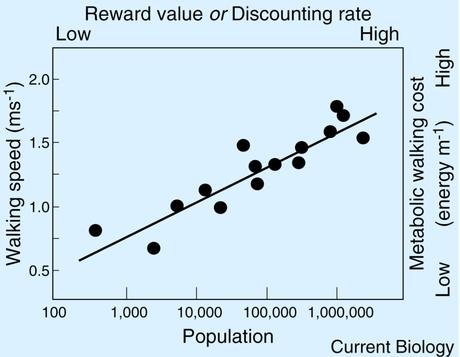A number of studies have shown that people in big cities move faster. Why is this?
Pontzer describes work by
Ahmed et al. suggesting that our brains use metabolic energy cost to determine the speed with which we (and other animals) move towards a reward.

For many tasks, such as walking, the metabolic energy (i.e., calories) expended per distance traveled is a function of speed; moving faster requires more energy per meter. A reward’s value can be a function of speed as well. Under a temporal discounting model, a reward’s value decreases the longer it takes to obtain it; food might decay or be lost to competitors, the comfortable seats on the rush-hour train might be taken. Given the cost:speed function for a given task and the value:time function for a given reward, one can solve for the speed that maximizes net return for a given action.
Ahmed and colleagues tested their model in a series of reaching tasks with human subjects and found strong support for it...despite its simplicity the model makes reliable predictions across a variety of different tasks and even across species. Analyzing the behavior of finches reported in an experimental study of foraging behavior, Ahmed and colleagues showed that their model correctly predicts whether the birds chose to walk (which is slow but metabolically inexpensive) or fly (fast but costly) to acquire food. When the time to acquire the food increased, its value as estimated by the discounting model decreased, and as predicted the birds chose to walk. In a separate analysis of isometric force production in human subjects, their model correctly predicted subjects’ decreasing sensitivity to task duration as the force exerted decreased.
That the model’s predictions work well across species suggests it may reflect a common, evolved neurobiological mechanism that is shared across species. Ahmed and colleagues suggest, for example, that the neural circuits involved in generating actions should be strongly coupled to the circuits involved in deciding between actions. Such shared, evolved neurological mechanisms are powerful tools for research, as they present a common framework for comparing behavioral strategies across species, tasks, and environments.
Pontzer's final paragraph:
For my fellow New Yorkers, Ahmed and colleagues’ model suggests two, mutually compatible reasons that we habitually walk faster, and less efficiently, than our relaxed, rural comrades (see figure above). We may perceive greater rewards are at stake, and given the remarkable sums of money exchanged each day in the city, that assessment may well be accurate for some. Alternatively, with over 8 million fellow primates foraging for the same resources, we may sense that the rewards we seek are slipping away more quickly — something to ponder next time you’re running for the train.
The mathematical model developed by Ahmed et al. is a bit more complex than is appropriate for a description here, but can be found in their paper.


